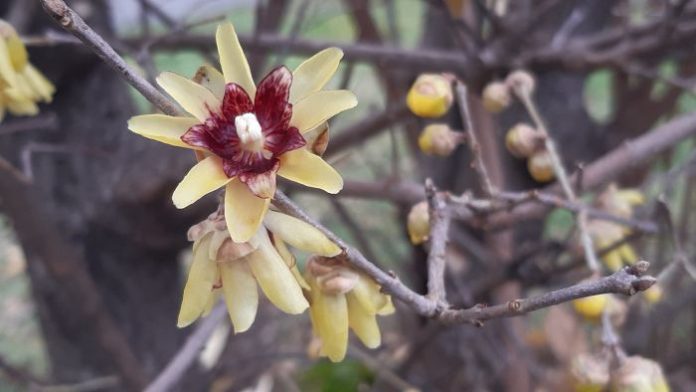
Calicanthus is a shrub native to China belonging to the calycanthaceae family. The shrub gives winter blooms (regardless of the climatic conditions) and from this comes its Greek name “Chimonanthus” literally “winter flower”. The main characteristic of the flower is the intense scent, delicate and intoxicating, perceptible directly on the plant. If the flowers fall or are cut away, the particular fragrance will be removed. The most common species of calicanth, resistant and rustic, is the chimonanthus praecox: its waxy flowers – of yellow colour externally and red-purple inside – bloom well before the plant has begun to produce the leaves. The shrub is therefore seemingly dry, in February-March, but covered with many and fragrant flowers in the shape of a bluebell.
Calicanto: legends and symbologies
It is said that a small robin, after a long and tiring flight, sought shelter from the cold and a place to rest – among the branches – but no tree wanted to help him. Exhausted and cold, the stubborn robin tried to rest on a small branch of calicanto that, with amazing kindness, offered him shelter and warmed him with his last yellowed leaves. The Lord, to reward the generous little tree for the beautiful gesture, let fall on its branches a rain of bright and fragrant stars that soon turned into flowers. Since that day the calicanto gives intoxicating and showy blooms to anyone who meets him in winter. Because of this narrative, in the language of flowers and plants, calicanth is a symbol of affection and protection.

Another legend tells the story of a dying child with a final wish: to hold a flower between his small and fragile hands. No plant responded to his mother’s desperate and tireless cry for help, except for the calicanto. Its gems opened and a beam of light swept away the naked branches on which appeared many, extraordinary, buds. The child – with the yellow and fragrant flower – recovered from his illness. Therefore, in addition to protection and affection, the calicanto symbolizes tenacity in hostilities and the ability to respond forcefully to the challenges of life, sometimes cold and raw: just like the flower of the calicanto that does not fear frost and gives everyone its lively bloom, so we too can overcome adversity and “blossom” at any time.
Properties and benefits of Calicanto
Calicanto is rich in plant hormones and acts as a natural tonic able to generate a state of well-being and sparkling energy. The scent alone helps against stress and fatigue restoring serenity and good vibes.
The dried flowers of calicanto, together with ginger and lemon balm roots, can be used to prepare purifying and relaxing herbal teas. Be careful not to mix the seeds with the flowers as the latter are poisonous and extremely dangerous if ingested.
The plant is effective against problems related to the winter season, therefore its essential oil is a practical remedy against redness and irritation from frost. In addition, a few drops of calicanto oil in the radiator diffusers improves the quality of sleep and makes the awakening, as much as possible, less oppressive!

Cultivation and care
Calicanto, because it is rustic, does not require special care and can be easily cultivated. It requires drained soils to avoid water stagnations. It is essential to provide, cyclically, organic substances (compost) so that it can develop in a luxuriant way. The exposure must be balanced between areas of shadow and those of light: the calicanto does not fear frost, so it should not be placed in places excessively sunny. No need for large watering. In summer it is possible to intervene with moderate water supplies according to the degree of dryness of the soil, in winter the typical rainfall of the season is often sufficient. Among the treatments to be repeated periodically, it is recommended the pruning operation – of excessively dry or extended branches – in not particularly humid days in order to speed up the healing of the wounds made with the cut. The calicanth can be cultivated both in pot and in the garden, but due to its ample shrubby conformation, it is preferable to plant it in the garden so that it can exhibit, in an optimal way, its growth potential.
“You think it’s all over, but then there’s always a robin singing.”
Paul Claudel






































